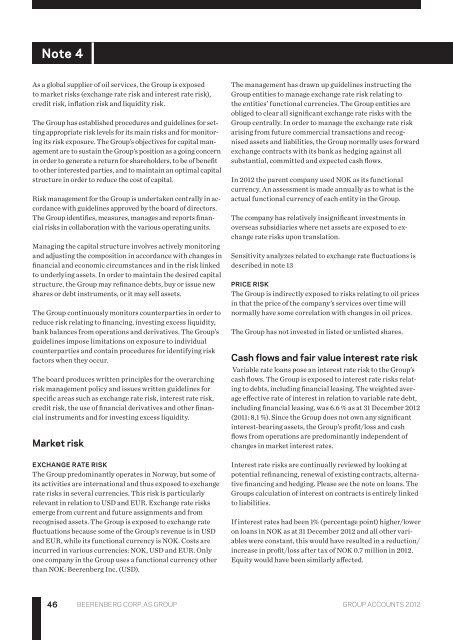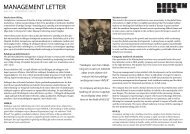Note 1 - Beerenberg
Note 1 - Beerenberg
Note 1 - Beerenberg
You also want an ePaper? Increase the reach of your titles
YUMPU automatically turns print PDFs into web optimized ePapers that Google loves.
<strong>Note</strong> 4<br />
As a global supplier of oil services, the Group is exposed<br />
to market risks (exchange rate risk and interest rate risk),<br />
credit risk, inflation risk and liquidity risk.<br />
The Group has established procedures and guidelines for setting<br />
appropriate risk levels for its main risks and for monitoring<br />
its risk exposure. The Group’s objectives for capital management<br />
are to sustain the Group’s position as a going concern<br />
in order to generate a return for shareholders, to be of benefit<br />
to other interested parties, and to maintain an optimal capital<br />
structure in order to reduce the cost of capital.<br />
Risk management for the Group is undertaken centrally in accordance<br />
with guidelines approved by the board of directors.<br />
The Group identifies, measures, manages and reports financial<br />
risks in collaboration with the various operating units.<br />
Managing the capital structure involves actively monitoring<br />
and adjusting the composition in accordance with changes in<br />
financial and economic circumstances and in the risk linked<br />
to underlying assets. In order to maintain the desired capital<br />
structure, the Group may refinance debts, buy or issue new<br />
shares or debt instruments, or it may sell assets.<br />
The Group continuously monitors counterparties in order to<br />
reduce risk relating to financing, investing excess liquidity,<br />
bank balances from operations and derivatives. The Group’s<br />
guidelines impose limitations on exposure to individual<br />
counterparties and contain procedures for identifying risk<br />
factors when they occur.<br />
The board produces written principles for the overarching<br />
risk management policy and issues written guidelines for<br />
specific areas such as exchange rate risk, interest rate risk,<br />
credit risk, the use of financial derivatives and other financial<br />
instruments and for investing excess liquidity.<br />
Market risk<br />
Exchange rate risk<br />
The Group predominantly operates in Norway, but some of<br />
its activities are international and thus exposed to exchange<br />
rate risks in several currencies. This risk is particularly<br />
relevant in relation to USD and EUR. Exchange rate risks<br />
emerge from current and future assignments and from<br />
recognised assets. The Group is exposed to exchange rate<br />
fluctuations because some of the Group’s revenue is in USD<br />
and EUR, while its functional currency is NOK. Costs are<br />
incurred in various currencies: NOK, USD and EUR. Only<br />
one company in the Group uses a functional currency other<br />
than NOK: <strong>Beerenberg</strong> Inc. (USD).<br />
The management has drawn up guidelines instructing the<br />
Group entities to manage exchange rate risk relating to<br />
the entities’ functional currencies. The Group entities are<br />
obliged to clear all significant exchange rate risks with the<br />
Group centrally. In order to manage the exchange rate risk<br />
arising from future commercial transactions and recognised<br />
assets and liabilities, the Group normally uses forward<br />
exchange contracts with its bank as hedging against all<br />
substantial, committed and expected cash flows.<br />
In 2012 the parent company used NOK as its functional<br />
currency. An assessment is made annually as to what is the<br />
actual functional currency of each entity in the Group.<br />
The company has relatively insignificant investments in<br />
overseas subsidiaries where net assets are exposed to exchange<br />
rate risks upon translation.<br />
Sensitivity analyzes related to exchange rate fluctuations is<br />
described in note 13<br />
Price risk<br />
The Group is indirectly exposed to risks relating to oil prices<br />
in that the price of the company’s services over time will<br />
normally have some correlation with changes in oil prices.<br />
The Group has not invested in listed or unlisted shares.<br />
Cash flows and fair value interest rate risk<br />
Variable rate loans pose an interest rate risk to the Group’s<br />
cash flows. The Group is exposed to interest rate risks relating<br />
to debts, including financial leasing. The weighted average<br />
effective rate of interest in relation to variable rate debt,<br />
including financial leasing, was 6.6 % as at 31 December 2012<br />
(2011: 8,1 %). Since the Group does not own any significant<br />
interest-bearing assets, the Group’s profit/loss and cash<br />
flows from operations are predominantly independent of<br />
changes in market interest rates.<br />
Interest rate risks are continually reviewed by looking at<br />
potential refinancing, renewal of existing contracts, alternative<br />
financing and hedging. Please see the note on loans. The<br />
Groups calculation of interest on contracts is entirely linked<br />
to liabilities.<br />
If interest rates had been 1% (percentage point) higher/lower<br />
on loans in NOK as at 31 December 2012 and all other variables<br />
were constant, this would have resulted in a reduction/<br />
increase in profit/loss after tax of NOK 0.7 million in 2012.<br />
Equity would have been similarly affected.<br />
46<br />
<strong>Beerenberg</strong> CORP. AS Group group accounts 2012












